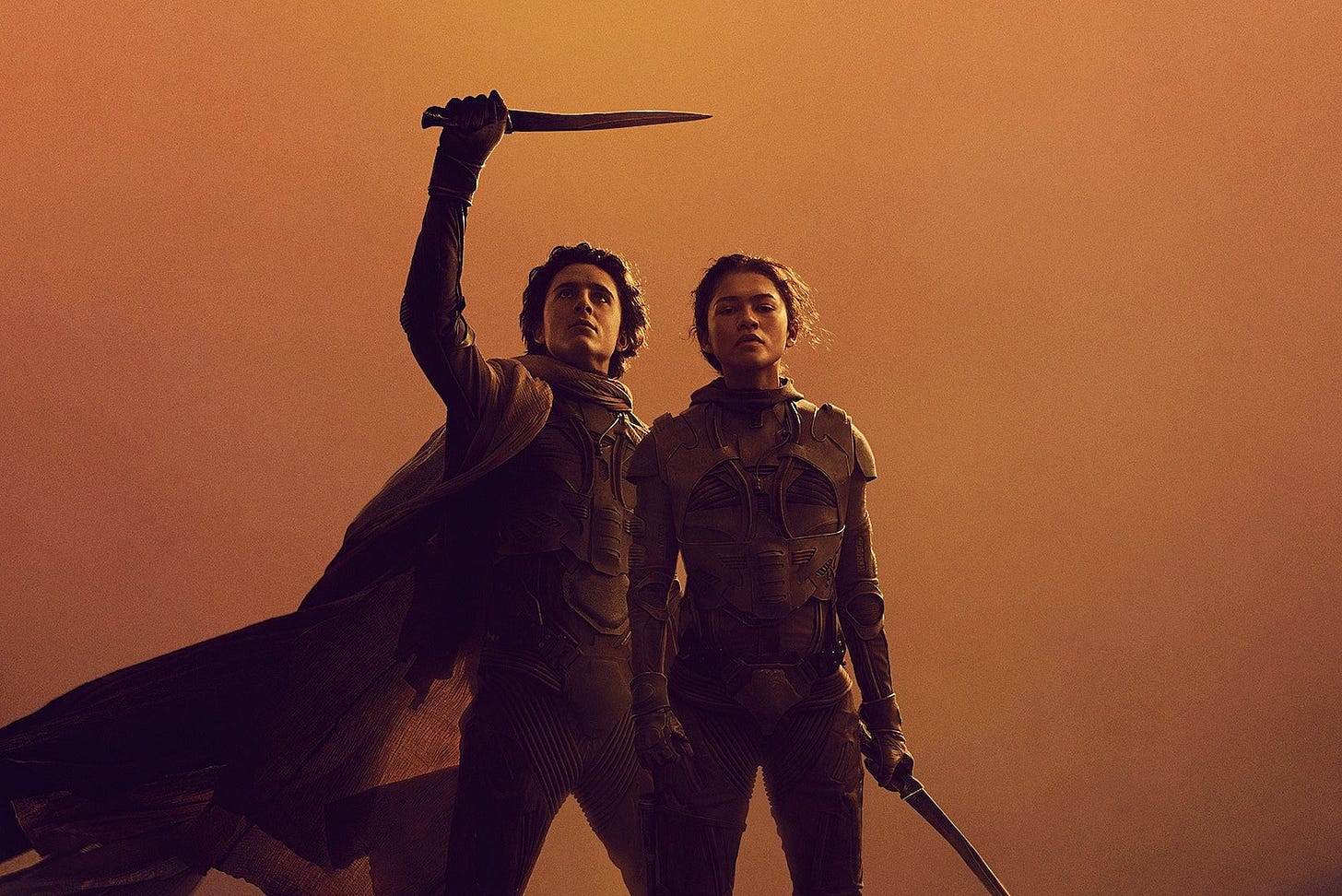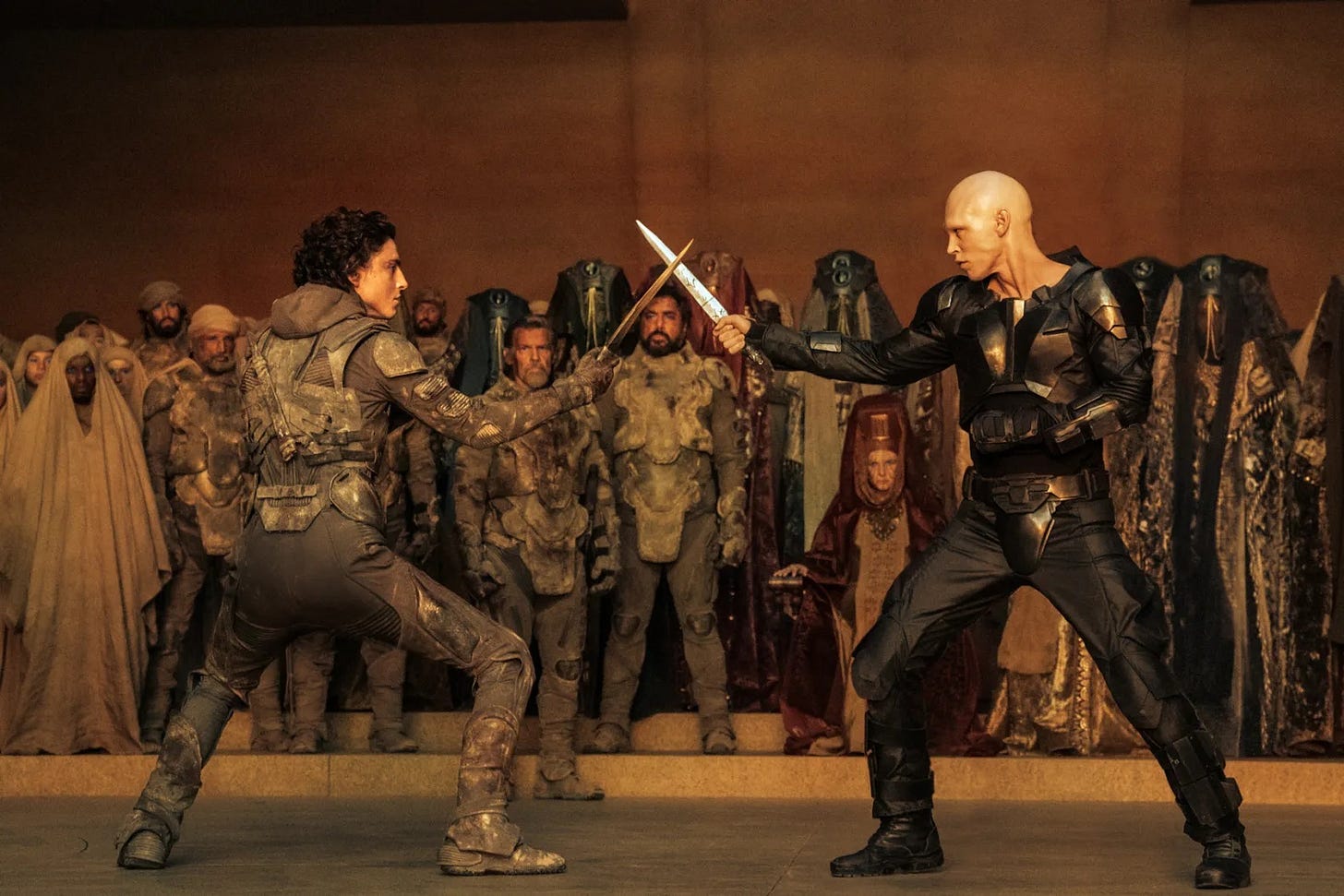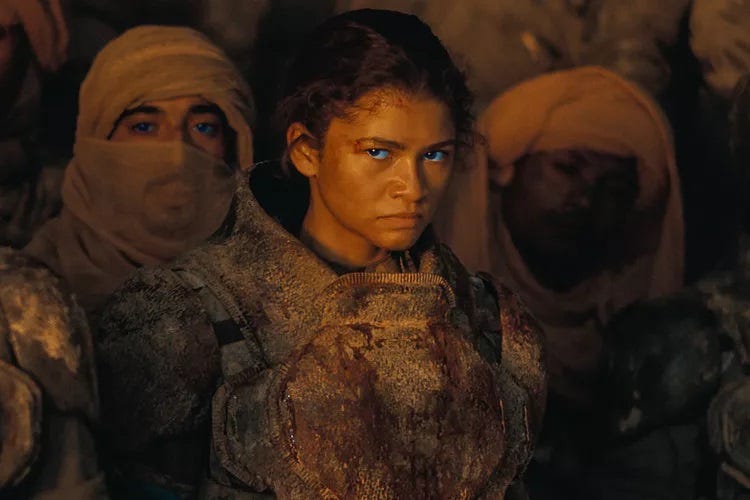Dune: Part Two (2024)
10/10
As flawless an adaptation of Frank Herbert’s novel as one could ask for—director Denis Villeneuve knocks it out of the park with the conclusion to his two-film take on Dune. In a lot of ways, Villeneuve has improved upon the source material, and you can make a solid case that the two combined films are even better than the book. I’ve rewatched Part One countless times since its release in 2021 and my anticipation was sky-high for Part Two, which even after reading all the rave reviews surpassed my expectations. Get ready for a lot of superlatives, because as a Dune fan, this movie blew me away on all fronts: acting, characters, plot, themes, dialogue, cinematography, action, special effects, music, costumes, world-building.
In terms of its impact on science fiction, Herbert’s original Dune is often compared to the influence that J.R.R. Tolkien’s The Lord of the Rings had on fantasy. The parallels apply to film too: Villeneuve’s Dune is the most artfully told big-screen genre epic since Peter Jackson brought Middle-earth to life two decades ago. Like the Lord of the Rings films, Dune creates a greater sense of immersion into this world through the blend of CGI and practical effects. Through his artistry, Villeneuve also shows the superfluous bloat of most Hollywood blockbusters, whose budgets now regularly top $250 million. By comparison, Dune: Part Two cost $190 million, which is still a sizable sum, yet it looks better than any of its more expensive counterparts.
Also like Jackson with Lord of the Rings, Villeneuve is able to to take a beloved nerd property dense with complex lore and make it accessible to the average moviegoer. That’s no small feat for a story that revolves around prophecy, religion, genetic engineering, neo-feudal interstellar politics, planetary ecology, and more. Befitting the immediacy of film as a visual medium, Dune streamlines Herbert’s sometimes clunky storytelling, jettisons dated or unnecessary elements, and expands characters that often felt flat on the page.
The most notable example is Chani (Zendaya), who is far more fleshed out here in probably the biggest change from the book. There have been some complaints about this from the usual reactionary whiners who complain about how anything they don’t like is “woke”. For the rest of us, it’s hard to see how Villeneuve’s changes aren’t a vast improvement on the source material. Whereas in the book, Chani was a one-dimensional character with little to her other than the thankless role of “love interest”, in Dune: Part Two she’s a driving forces in the story. Here Chani has agency, gets her share of badass action scenes, and continually challenges Paul Atreides (Timothée Chalamet) on his relation to the Fremen as well as the prophecies—seeded by the Bene Gesserit sisterhood for many generations—that he may be the Messiah.
In a film with such a stacked cast, all the actors deliver. Chalamet needs to be singled out for how he convincingly portrays Paul’s arc from callow youth to charismatic and, when necessary, ruthless leader. Lady Jessica (Rebecca Ferguson) was my favourite part of the first film, and her character’s Machiavellian tendencies come to the fore in Part Two. Austin Butler’s villainous Feyd-Rautha Harkonnen was the character I was most looking forward to seeing. I’ve been a fan of Butler’s since his incredible performance in Elvis, and he does not disappoint. Villeneuve holds back Feyd’s introduction until surprisingly late, when he makes his debut with a vivid gladiatorial fight shot in black and white. There’s not a trace of Presley in Butler’s chilling, murderous Feyd. Another great addition is Florence Pugh’s Princess Irulan, who exudes a regal intelligence. Stilgar (Javier Bardem) has a greatly expanded role from Part One and provides some of the film’s funniest moments, but above all embodies the faith that many of the Fremen have in Paul.
The cinematography is staggering in its beauty, lighting, and scene composition. Right from the beginning, we get stunning images such as Harkonnen troops silently soaring upwards with anti-gravity boots across the desert landscape. Their confrontation with Paul, Chani and the Fremen is the first of many great action sequences, which also include raids on Harkonnen spice harvesters and the climactic knife fight, advertised heavily in the trailers, between Paul and Feyd. One of the most memorable scenes is when Paul learns to ride a sandworm, where Villeneuve takes us right into the action and makes us feel like we’re experiencing this moment with Paul. The moment when Fremen ride sandworms into battle makes for jaw-dropping imagery. This the kind of film you want to see on the biggest screen possible.
Perhaps most impressive is how Villeneuve refuses to dumb things down. The film includes many fascinating dialogues about prophecy: where some of the Fremen see Paul as their liberator, others dismiss the concept of a messiah as encouraging inaction and subjugation to an oppressor. Compared to Star Wars, Dune does not shy away from more intellectual concerns. It fully dives into some of Herbert’s more head-spinning concepts, respecting the ability of its audience to understand them and rewarding their attention.
There’s so much to take away from this film and I’m already looking forward to repeat viewings. When I reviewed Part One, I gave it a 9/10 only because it was just the first part of the story. Having seen the complete two-part saga, I can now safely declare both parts 10/10, and I’m excited to watch the entire 5-hour, 20-minute story in its entirety. This is epic cinema at its finest, ranking up there with Lawrence of Arabia and The Lord of the Rings. Villeneuve says he’s already working on the next instalment, an adaptation of Dune Messiah, but I’ll be buying another IMAX ticket to see this movie again as soon as possible. I can’t wait to return to Arrakis.





